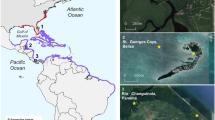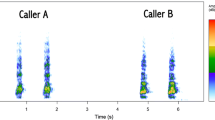Summary
An analysis of alarm calls of long-tailed squirrels demonstrates that the calls of the conspecificCitellus parryi populations of Alaska and North Siberia differ more from one another than those ofC. parryi of Alaska andC. undulatus of Central Asia and South Siberia. The hypothesis is suggested that a pleistocene relic population ofC. undulatus exists in North-West Alaska.
Similar content being viewed by others
References
J.W. Robinson and R.S. Hoffmann, Syst. Zool.24, 79 (1975).
E.A. Liapunova and N.N. Vorontsov, Experientia26, 1033 (1970).
A.A. Nikolski, Zool. Zhurnal58, 1183 (1979).
H.R. Melchior, Oecologia,7, 184 (1971).
Melchior uses the outdated terminology ‘Citellus undulatus’ forC. parryi as may be inferred from the English name used for the species.
P. Woldstedt, Das Eiszeitalter, vol. 3, Enke, Stuttgart 1965.
Author information
Authors and Affiliations
Additional information
In the American literature the genus is often termed Spermophilus.
Rights and permissions
About this article
Cite this article
Nikolski, A.A., Wallschläger, D. On the specific status of holarctic long-tailed squirrels; a bioacoustical study. Experientia 38, 808–809 (1982). https://doi.org/10.1007/BF01972284
Published:
Issue Date:
DOI: https://doi.org/10.1007/BF01972284




